

2025 Stata Conference • Nashville, TN • 31 July–01 August
Updates to multivariate GARCH were introduced in Stata 12.
Order |
MGARCH stands for multivariate GARCH, or multivariate generalized autoregressive conditional heteroskedasticity. MGARCH allows the conditional-on-past-history covariance matrix of the dependent variables to follow a flexible dynamic structure.
Stata’s new mgarch command fits MGARCH models. mgarch implements diagonal vech and conditional correlation models. Conditional correlation models are also new to Stata 12. Conditional correlation models use nonlinear combinations of univariate GARCH models to represent the conditional covariances. mgarch provides estimators for three popular conditional correlation models—CCC, DCC, VCC—also known as constant, dynamic, and varying conditional correlation.
Below we analyze daily data on returns of Toyota, Nissan, and Honda stocks. We include the lag of the Nissan stock in the mean equation for Honda. We specify one ARCH term and one GARCH term for the conditional variance equation of each company.

And the results are
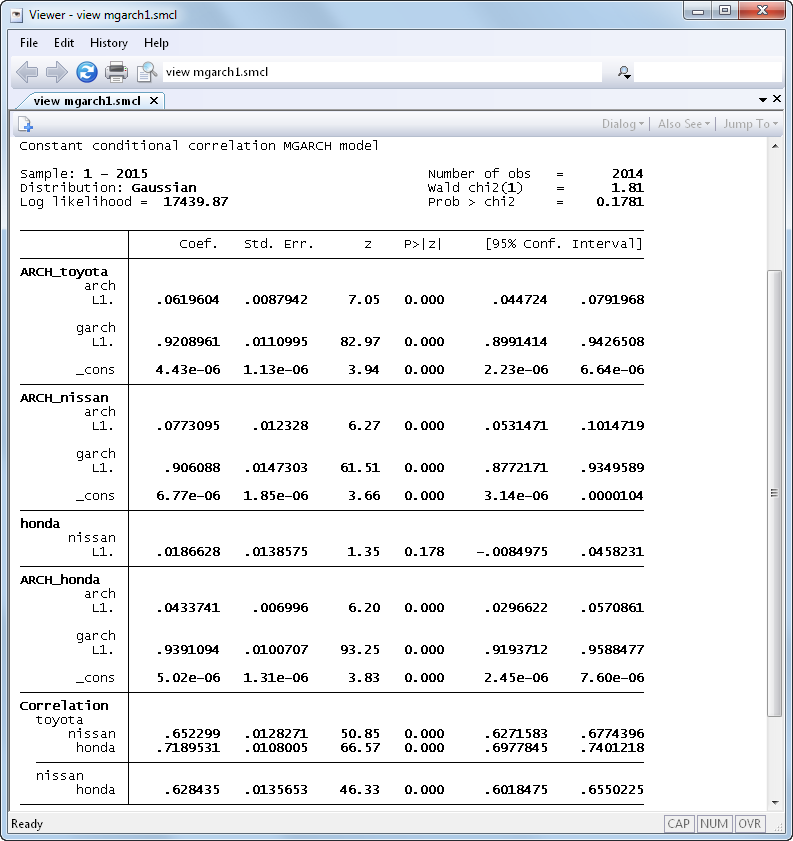
Having estimated our model, we can now forecast the conditional variances 50 time periods into the future.
. tsappend, add(50) . predict H*, variance dynamic(2016)
We can graph the result:
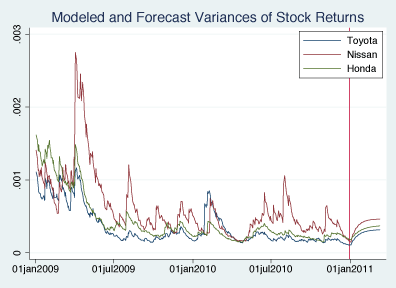
Above, we fit a CCC model. We could instead fit a DCC model in which the correlation matrix at each time period is modeled as a weighted average of its own past and recent shocks.
Below we fit a bivariate model of stock returns and specify that the error term follows a multivariate Student’s t distribution:

And the results are
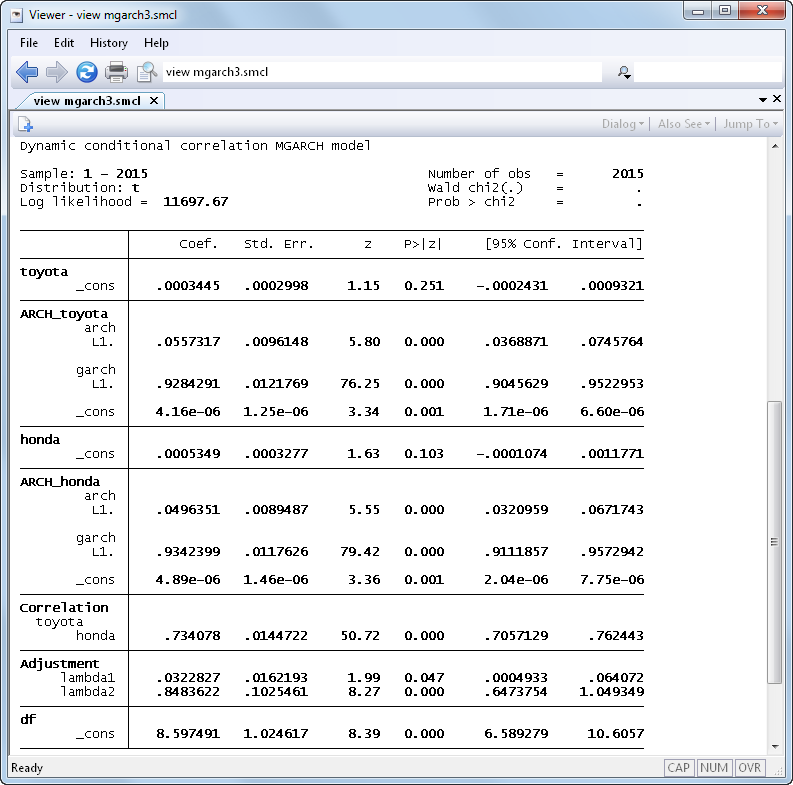
The DCC model reduces to the CCC model when the adjustment parameters that govern the dynamic correlation process are jointly equal to zero. We can perform a Wald test to test this hypothesis.
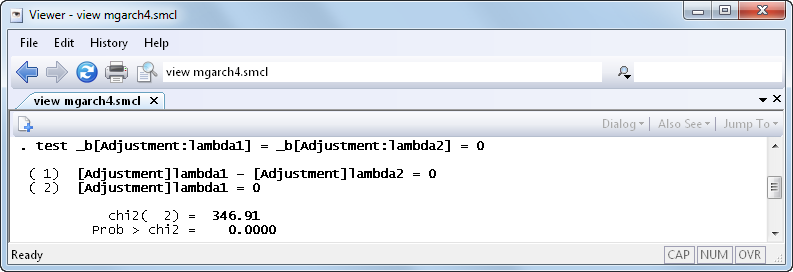
We have fit a CCC model and a DCC model. We could fit a VCC model in which the correlation matrix is modeled as a weighted average of its own past and averages of recent shocks.
To illustrate the flexibility of the conditional correlation estimators, we specify each variance equation separately in the mgarch command below. We include two ARCH terms, one GARCH term, and an independent variable in the variance equation of Honda and one ARCH term for the variance equation of Toyota.
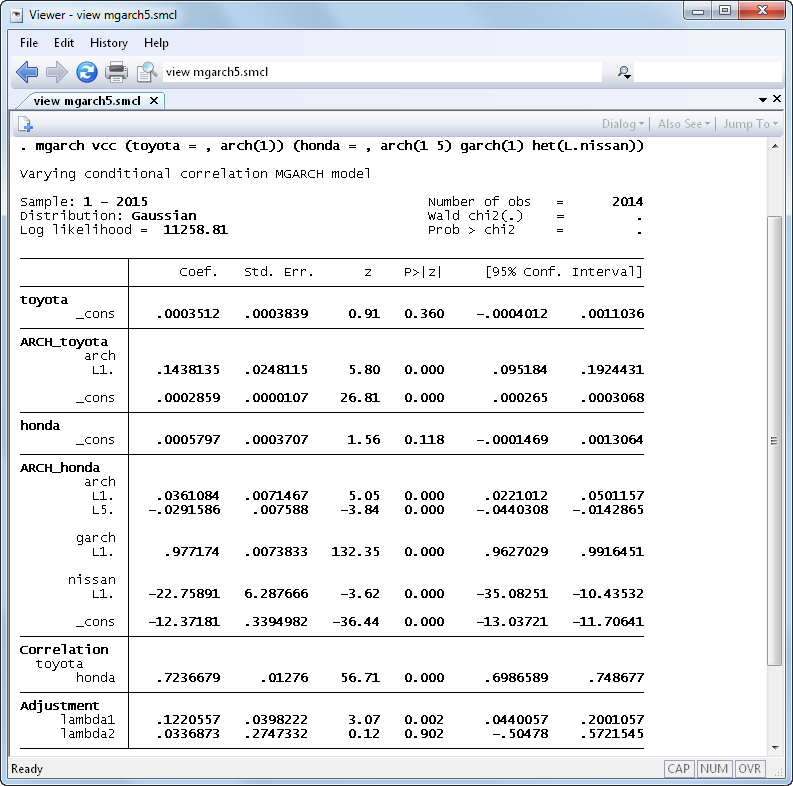
We have demonstrated CCC, DCC, and VCC. We could also demonstrate diagonal vech, except Stata 11 could do that. New in Stata 12 are multivariate Student’s t errors in the diagonal vech model.
For a complete list of what’s new in time-series analysis, click here.
See New in Stata 19 to learn about what was added in Stata 19.
Learn
Free webinars
NetCourses
Classroom and web training
Organizational training
Video tutorials
Third-party courses
Web resources
Teaching with Stata
© Copyright 1996–2025 StataCorp LLC. All rights reserved.
×
We use cookies to ensure that we give you the best experience on our website—to enhance site navigation, to analyze usage, and to assist in our marketing efforts. By continuing to use our site, you consent to the storing of cookies on your device and agree to delivery of content, including web fonts and JavaScript, from third party web services.
Cookie Settings
Last updated: 16 November 2022
StataCorp LLC (StataCorp) strives to provide our users with exceptional products and services. To do so, we must collect personal information from you. This information is necessary to conduct business with our existing and potential customers. We collect and use this information only where we may legally do so. This policy explains what personal information we collect, how we use it, and what rights you have to that information.
These cookies are essential for our website to function and do not store any personally identifiable information. These cookies cannot be disabled.
This website uses cookies to provide you with a better user experience. A cookie is a small piece of data our website stores on a site visitor's hard drive and accesses each time you visit so we can improve your access to our site, better understand how you use our site, and serve you content that may be of interest to you. For instance, we store a cookie when you log in to our shopping cart so that we can maintain your shopping cart should you not complete checkout. These cookies do not directly store your personal information, but they do support the ability to uniquely identify your internet browser and device.
Please note: Clearing your browser cookies at any time will undo preferences saved here. The option selected here will apply only to the device you are currently using.